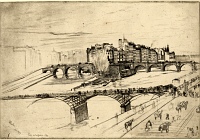Etchings Institutions search term: dunthorne
Isle de la Cité, Paris | ||
| Number: | 63 | |
| Date: | 1859 | |
| Medium: | etching and drypoint | |
| Size: | 204 x 294 mm | |
| Signed: | 'Whistler -' at lower left | |
| Inscribed: | 'Dec. 1859.' and 'Paris de la Galerie d'Op' at lower left | |
| Set/Publication: | no | |
| No. of States: | 1 | |
| Known impressions: | 11 | |
| Catalogues: | K.60; M.60; T.19; W.55 | |
| Impressions taken from this plate (11) | ||
KEYWORD
TITLE
'Paris de la Galerie d'Ap[ollon]' (Whistler, 1861). 1
'View of Paris from the Louvre' (1872, British Museum). 2
'L'Isle St. Louis, Paris' (Ralph Thomas, Jr (1840-1876), 1874). 3
'Paris. From window of Louvre' (Union League Club, 1881). 4
'Paris: The Isle de le Cité' (Frederick Wedmore (1844-1921), 1886). 5
'Isle de la Cité' (Whistler, 1891). 6
'Paris. Pont des Arts. (Isle de la Cité)' (Beatrice Whistler (1857-1896), 1890/1892). 7
'Isle de la Cité - Paris' (possibly Rosalind Birnie Philip (1873-1958), 1903/1935). 8
'Isle de la Cité, Paris' (Howard Mansfield (1849-1938), 1909). 9
Beatrice Whistler added 'Pont des Arts' (the name of the bridge that is in the foreground) to the title, but most writers and cataloguers including Whistler emphasized the island rather than the bridges. The inscription by Whistler on the plate might suggest a fuller title such as 'Isle de la Cité, Paris, from the Galerie d'Apollon', including the most popular elements in the recorded titles. However, the shorter title, Isle de la Cité, Paris, as used by Mansfield, suffices to identify the etching clearly.
1: Etched on the copper plate.
2: B.M. Print Room Register of Purchases..., 1872.
3: Thomas 1874 (cat. no. 19).
4: New York 1881 .
5: Wedmore 1886 A (cat. no. 55).
6: Whistler to Wunderlich, 10 June 1891, GUW #13060.
7: GUW #12715.
8: Envelope containing copper plate, Hunterian Art Gallery.
9: Mansfield 1909 (cat. no. 60).
DESCRIPTION
SITE
 ).
).Ralph Thomas, Jr (1840-1876) identified the scene as follows: 'View taken from the "Galérie d'Appolon" of the Louvre, showing three bridges over the Seine; the objects are, of course, all reversed.' 10 Wedmore corroborated this, calling it 'A view looking along the Seine; ... taken from a window of the Galerie d'Apollon at the Louvre. ' 11
Mansfield said that on an impression in his own collection Whistler had written 'From a window in Louvre.' 12 However, this has not been confirmed.
DISCUSSION
13: 'Four Masters of Etching by Frederick Wedmore. ... (The Fine Art Society)', The Academy, 23 June 1883, pp. 443-44.
14: Wedmore 1886 A (cat. no. 55).
Meryon's 1854 etching, L'abside de Notre-Dame de Paris from the series Eaux-fortes sur Paris 16 is often compared to Whistler's view. Lochnan compared Whistler's Paris etching both with the work of Meryon and with Whistler's London etchings of the same date. She considered 'was probably intended as a tribute to Meryon, and added:
15: Pennell 1908 , I, p. 83.
16: Delteil, Loys, W., H., Catalogue raisonné of the etchings of Charles Meryon, New York, 1924 (cat. no. 38). Schneiderman, Richard S., Raysor II, Frank W, The Catalogue Raisonné of the Prints of Charles Meryon, London, 1990 (cat. no. 45). British Museum 1862,1011.706, http://www.britishmuseum.org (accessed 2012).
17: Lochnan 1984 , p. 109.
